Subscapularis Muscle
Table of Contents
What is Subscapularis Muscle ?
- The subscapularis is a triangular shoulder muscle situated in the subscapular fossa of the scapula. Attaching between the scapula & the proximal humerus, it is one of the 4 muscles of the rotator cuff, along with supraspinatus, infraspinatus, & teres minor.
- Rotator cuff muscles act to combine work for stabilization & steer the humeral head within the glenoid cavity during many movements of the upper extremity.
- Each muscle of the rotator cuff also does its own specific role, & the main action of the subscapularis is to rotate the arm on the shoulder joint internally.
Relations of Subscapularis Muscle
- The subscapularis muscle contributes the majority of the posterior wall of the axilla, seeing the contents of the axilla with its anterior surface. Serratus anterior completely covers its superolateral part, while the coracobrachialis & biceps brachii muscles are situated over its inferomedial part. Fascial spaces between the subscapularis, serratus anterior muscles, & the thoracic cage are filled with loose connective tissue that inhibits the gliding motions of the scapulothoracic joint.
- The central part of the muscle is passed by the cords of the brachial plexus & their branches, the axillary nerve, axillary artery, & vein.
- The posterior surface of the muscle’s tendon is mixed with the fibrous capsule of the glenohumeral joint & is continuous with the tendons of supraspinatus, infraspinatus, teres minor, & long head of triceps brachii. These tendons combine to comprise the rotator capsule surrounding the shoulder joint.
The subscapularis muscle participates in the formation of the 3 intermuscular axillary spaces;
- Quadrangular space; subscapularis made the anterior boundary of this space, while the shoulder joint capsule & teres minor bounce it superiorly, teres major inferiorly, & the surgical neck of the humerus laterally. This space is crossed by the axillary nerve & posterior circumflex humeral artery and vein.
- Upper triangular space, in which subscapularis is made up of the anterior border. The space is filled by the teres major inferiorly, teres minor posteriorly, & long head of triceps brachii laterally. The circumflex scapular artery crosses this space.
- In lower triangular space (triangular interval), here the subscapularis made up the anterior border. Teres major, long head of triceps brachii & the humerus comprise the posterior, medial, & lateral borders of this space, respectively. This space serves as a passage for the radial nerve & deep brachial artery.
Origin of Subscapularis Muscle
- The subscapularis is a tough triangular muscle that filled the subscapular fossa of the scapula. Located posterolateral to the thoracic cage, it begins as a wide muscle whose medial 2/3rd originates from the subscapular fossa of the scapula & from several tendinous intramuscular septa at the ridges of the fossa. The remaining fibers originate from an aponeurosis that covers the posterior surface of the lateral 3rd of the muscle.
Insertion
- From the costal surface of the scapula, the muscle fibers route laterally, slowly narrowing towards a round tendon that courses towards the proximal humerus. The large subscapular bursa that relates to the shoulder joint is different from the subscapularis tendon from the neck of the scapula. The tendon then ends at the lesser tubercle of the humerus & anterior part of the articular capsule of the shoulder joint. As it proceeds towards the humerus, the tendon continuity with the tendon of the teres major muscle. In fact, these 2 muscles share the same innervation & actions & are generic considered functional muscular units.
Nerve Supply
- The nerve supply of the subscapularis muscle is by the upper & lower subscapular nerves (C5-C6), which stem from the superior & posterior cords of the brachial plexus, apart.
Blood supply
Vascular supply to the subscapularis muscle arrives from a series of branches of the subclavian artery;
- Artery of Subscapular, a branch of the axillary artery
- Axillary artery, a continuation of the subclavian artery
- Artery of Suprascapular, which branches off the subclavian artery through the thyrocervical trunk.
Function of Subscapularis Muscle
- The subscapularis muscle is the single medial (internal) rotator of all four rotator cuff muscles. Because of its different axis of pull, from the proximal humerus to the costal surface of the scapula, subscapularis diverges medially & rotates (internal rotation) the humerus head within the glenoid fossa. To a lesser extent, subscapularis also does adduction of the arm. The fluency of these 2 motions is seen in walking when the arms swing.
- Together with the other rotator cuff muscles, subscapularis helps the making of concavity compression, a stabilization mechanism in which compression of the humerus into the concavity of the glenoid fossa helps to prevent its dislocation by translating forces. The subscapularis is a main stabilizer of the shoulder joint when the deltoid, pectoralis major, biceps, a & triceps brachii muscles are active. These muscles are responsible for many over-head movements of the arm (e.g. throwing, pulling downwards), during which the force of subscapularis inhibits upward shoulder dislocation. However, during these particular motions, subscapularis is also more prone to impingement.
- The subscapularis muscle also assists in coordination between the motions of the shoulder & scapulothoracic joints. Respectively the muscles of the back main work on the scapulothoracic joint, subscapularis assists by ensuring that scapula motions follow the shoulder, in actions like reaching for a highly or overhead placed object.
Clinical Significance of Subscapularis Muscle
- Causes of shoulder pain due to subscapularis, reason may include tendonitis, tendinopathy, & tears.
- Tendonitis: Tendonitis of the subscapularis generally occurs due to when it comes in proximity to the coracoid process from the overuse in throwing activities & overhead athletes.
- Tendinopathy: Tendinopathy occurs when the condition becomes more severe/chronic, & remodeling of the tendon begins to occur. Rotator cuff tears are prone to occur with chronic degenerative tears from over-head use or acutely in athletes with overhead movement.
- Subscapularis Tears: The incidence of subscapularis tears is rare than that of other rotator cuff tendons. When tears occur, it is because of an anterior shoulder dislocation, fall on the outstretched arm during glenohumeral abduction, iatrogenic following anterior shoulder surgery, lesser tubercle avulsion, or associated with rotator cuff tear.
Stretching Exercise for Subscapularis Muscle

Pendulum stretch
- This exercise is done first.
- Relax the shoulders.
- Stand or lean over slightly and allow to affected arm to hang down.
- The arm Swing in a small circle — about the foot diameter.
- Perform the 10 repetitions in each direction, once a day.
- When the improve in symptoms, increase the swing diameter, but not force it.
- If the patient is ready for more circle, then increase the stretch with hold lightweight for the swinging arm.
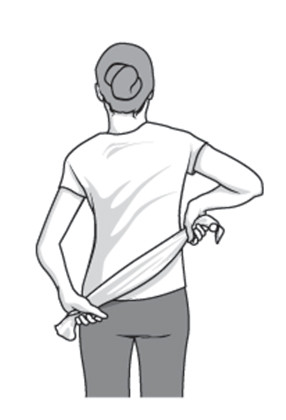
Towel stretch
- Hold the three-foot-long towel on the one end behind the back and hold the opposite end with the other hand.
- The towel is held in position of horizontal.
- Use the good arm to pull the affected arm upward and stretch it.
- It is also performed in an advanced version of the exercise with the towel drape over the good shoulder.
- The bottom of the towel is held in the affected arm & pull the hand toward the lower back with the unaffected arm.
- This exercise is performed 10 to 20 times per day.
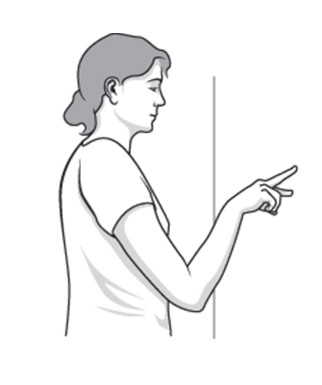
Finger walk
- Face the wall three-quarters of arm’s length.
- Reach out & touch the wall at the side of the waist level with the fingertips of the affected arm.
- With the elbow slightly bent, slowly walk to fingers up the wall, like a spider, until the raised arm is as far as comfortable. the finger only the work, not the shoulder muscles.
- Slowly down the lower arm & repeat.
- Perform the exercise 10 to 20 times per day.
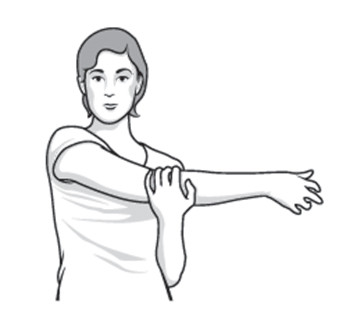
Cross-body St-reach Sit and stand
- Use the unaffected arm to lift the affected arm at the elbow & bring the arm up & across the body,
- Exerting gentle pressure to stretch the shoulder.
- This stretch is held for 15 to 20 secs.
- This exercise is repeated 10 to 20 times per day.
Armpit stretch

- Use the good arm, & lift with the affected arm about breast-high.
- Gently bend the knees & open up the armpit.
- Deepend the knee bend slightly, & gently stretch the armpit.
- With each knee bend & stretch a little further, but not force it.
- Do this exercise 10 to 20 times each day.
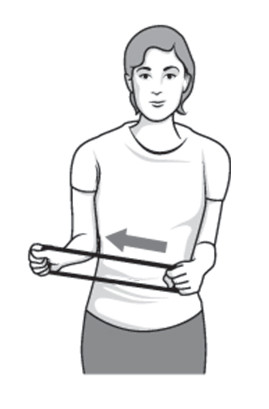
Outward rotation
- Grab the rubber exercise band between the hands with the elbows at an angle of 90-degree near the sides.
- Rotate to the lower part of the affected arm outward to 2 or 3 inches, and hold for 5 secs.
- Repeat this exercise 10 to 15 times, one time in the day.
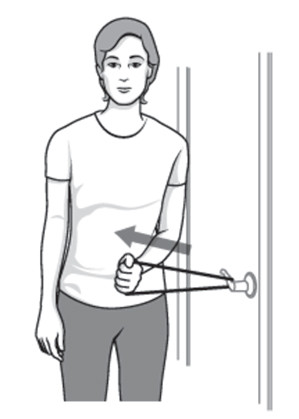
Inward rotation
- Stand to the closed door & hook one end of the rubber exercise band surrounding the doorknob.
- Grab the other end in the hand of the bad arm, holding the elbow at an angle of 90-degree.
- Pull the band toward the body two or three inches and hold for five secs.
- Repeat this exercise 10 to 15 times, once a time in the day.
Bent-arm Wall Stretch
- The patient is Assume a split stance, Right leg is in the front & the left leg in the back, in a doorway & at the end of a wall.
- Then Bring the left arm up to shoulder height & position the palm & inside of the arm on the wall surface or doorway.
- The patient arm looks like a goal post.
- Then Gently press the chest through the open space to feel the stretch.
- Moving the arm higher & lower which is allow to you stretch the various sections of the chest.
- Then Repeat this exercise on the other side.

Bent Arm Scaption Plane Stretch
- You are kneeling position next to an elevated surface.
- Then put one palm down on the surface with the elbow joint pointed up.
- Try to roll the shoulder joint capsule in & out.
- You feel the best stretch in your pec during this stretching pose.
- Then move in & out of the stretch 10 times & hold this exercise for 15-30 secs.
- Do the 1 set of 3 reps & 3 times per day.
Extended Child’s Pose on Fingertips
- The patient is Kneeling on the floor.
- Try to Touch the big toes together & the patient is sitting on the heels.
- Next, separate the knee joint about as wide as the hip joint.
- Then Bend the forward from the hip joint & walk the hands out as far in front of them as possible.
- With the arms extended palms are facing down then come up onto the fingertips as if the ball underneath the palms & melts the chest toward the floor.
Strengthening Exercise for Subscapularis Muscle
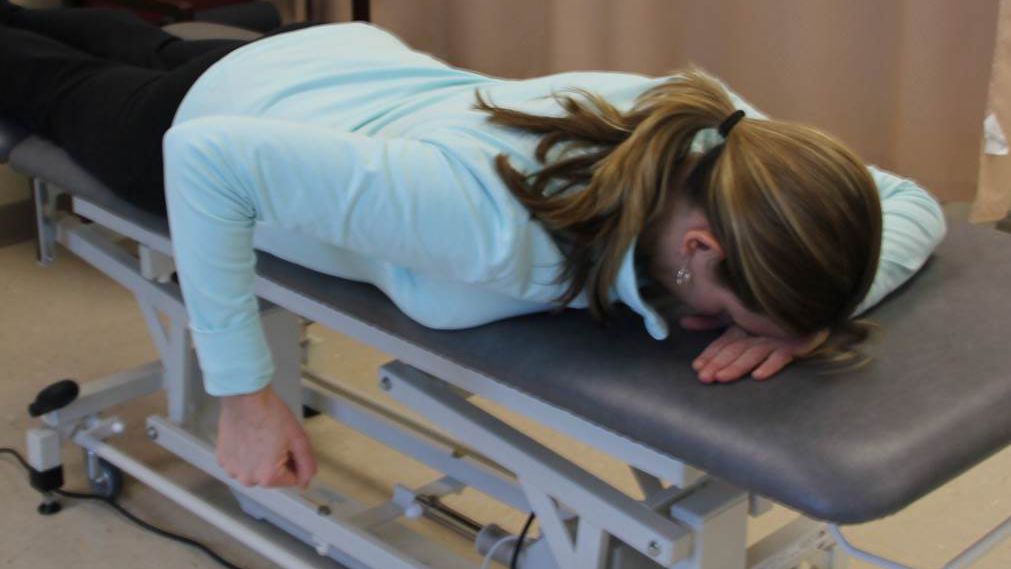
Scapular Stabilization Exercises
- This is used for scapular stabilization
- This exercise is performed with the help of another patients or therapists and also perform.
- This exercise performs in the prone position.
- Exercise in the I, T, and Y pattern.
- Repeat this exercise 10 times in one session and perform it 3 times a day.
Shoulder joint internal rotation isometric exercise
- To perform shoulder internal rotation you are standing facing a door frame & and outside the wall corner.
- The affected shoulder joint is near the door corner.
- Then flexed your elbow joint up to 90 degrees & make a fist.
- Try to gently press the towel into the corner wall & door jamb like as you rotate your arm inward towards your belly.
- Hold this pressing for 5 to 10 seconds & slowly release.
- Do the 10 to 15 repetitions.
CHIN-UPS
- Hold the bar, hands shoulder-width apart palms with an underhand grip
- Begin with arms completely straight & pull the chest up to the bar as high as you can
- Hold briefly at the top then return to the initial position
- Complete the 5 to 10 repetitions.
- Repeat 3 sets at a time.
- Every exercise does the 2–3 times per day.
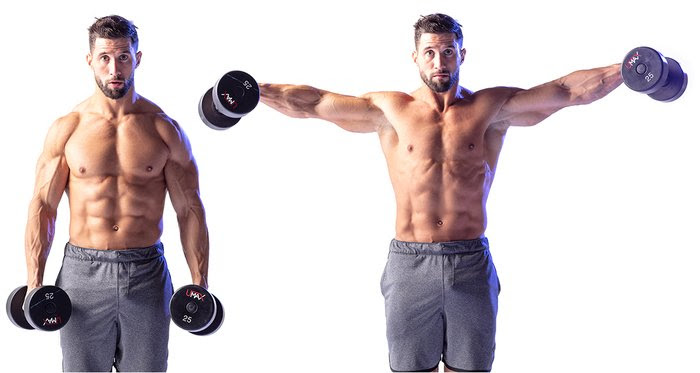
Lateral raises
- First, hold a pair of light dumbbells for this exercise.
- You are standing with the feet slightly wider than the hip joint width apart.
- Try to raise the weights to the sides till are at shoulder level.
- Must be remembered to engage the core muscles & slowly lower the weights down to the sides.
- Repeat this exercise for 2 sets, in every set consisting of 12–15 reps & 3 to 4 times per week.
Internal rotation with abduction
- Attach tie theraband to the doorjamb well above the head.
- Turn the back to the door.
- With the elbow bent at 90-degree angle & the arm out to
- The side rotate the arm down, so that the hand is even with
- The hip, against the resistance of a theraband.
- Slowly return to the initial position & repeat.
Reverse Lawn mower starter
- Attach the theraband to a doorjamb well above the head.
- Turn so you are alighnment to the door.
- Start with the arm above the head & out to the side.
- Then pull the band up towards the against pocket in the reverse movement of starting a lawn mower.
Shoulder blade squeeze
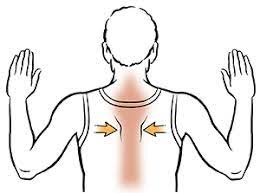
- You are Standing up straight.
- Bring the elbow joint back & inward.
- Pulling the shoulder joint blades down & back.
- Then return to the starting position.
- Repeat this exercise 10 times in 1 session & repeat this session 3 times per day.
Shoulder raises
- You are standing or sitting position.
- This exercise starts with your arms by your side & a straight back.
- Then slowly lift your shoulder joint toward your ears.
- Hold this exercise for 10 seconds & return to the slowly starting position.
- Repeat this exercise 10 times in 1 session & 3 sessions per day.

Shoulder rolls
- First Maintain good posture in the standing or sitting position.
- Then Roll your shoulders joint up, back & down.
- Do this exercise movement 10 times.
- Then roll your shoulder joint up, forward & down 10 times.
- Repeat this exercise 10 times in 1 session & 3 sessions per day.
Wide-legged standing forward bend

- You are standing with your feet wider than hip distance with your toes facing forward.
- Then Interlace your hands behind your back & open your chest.
- Engage your leg muscles & must keep a slight bend in your knee joint.
- Hinge at the hip joint to fold forward & bringing your arms over your head toward the floor.
- Then Allow your head to hang down & tuck your chin in slightly to your chest.
- Remain in this pose for up to 1 minute.
- Repeat this exercise 10 times in 1 session & 3 sessions per day.
T, Y & I movements
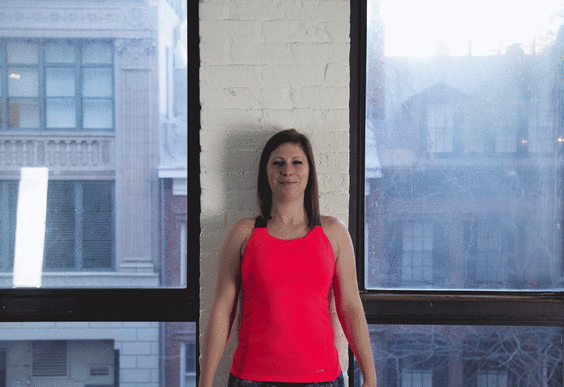
- Start this exercise With your back to a wall & stand with your palms facing out.
- Then slowly bring your arms up to make a T shape & must be keeping your arms & back in contact with the wall.
- After that Continue to bring your arms up to make a Y shape, then do the I shape & try to touch your thumbs overhead.
- But must be kept Focus on your shoulder blades flat against the wall.
- Repeat this all movement 10 times in every shape & 3 sessions per day.
Cow face pose
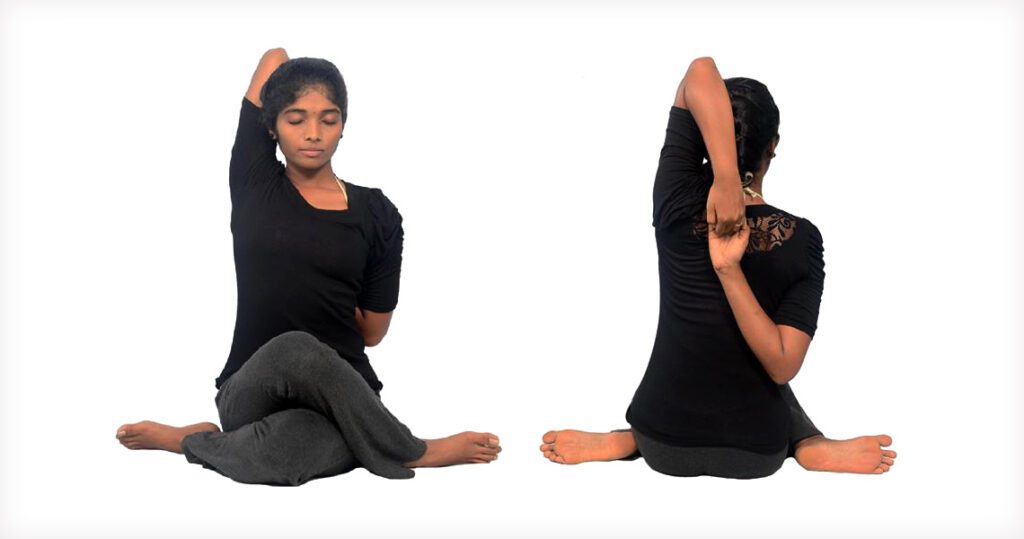
- Start this exercise in the sitting position & take to your left elbow joint up to the side of your head with your hand facing down your spine.
- With the help of your right hand to draw your left elbow joint over to the right as your hand moves further down your spine.
- When you feel comfortable you can also bend your right arm & bring your right hand up to clasp your left hand.
- Hold the pose for 1 minute.
- Repeat this exercise 10 times in 1 session & 3 sessions per day.
Eagle arms spinal rolls
- In the sitting position, extend your arms out to the sides.
- Cross your elbows joint in front of your body with place your right arm on top.
- Then Bend your elbow joint & placing the backs of your forearms & hands together.
- Try to reach your right hand around to bring your palms together.
- Hold this position for 30 seconds.
- During the exhale, roll your spine as your draw your elbow joint in toward your chest.
- During the inhale, open your chest & lift your arms.
- Then Continue this movement for 1 minute.
- Repeat this exercise 10 times in 1 session & 3 sessions per day.
Cross-body arm swings
- You are standing with the feet hip-width apart.
- During Inhale lift the arms out to the sides & squeezing the shoulder blades together.
- During Exhale gently bring the arms in toward each other.
- Try to Cross the right arm under the left must keep both arms straight.
- During the Inhale & swing the arms back out to the sides & squeezing the shoulder blades together.
- During the Exhale & gently swing the arms in toward each other again.
- Cross the left arm under the right & must keep both arms straight.
- Repeat this exercise 10 times in 1 session & 3 sessions per day.

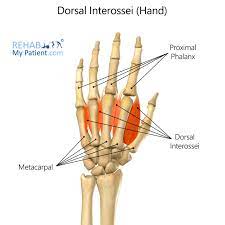
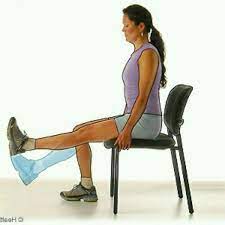
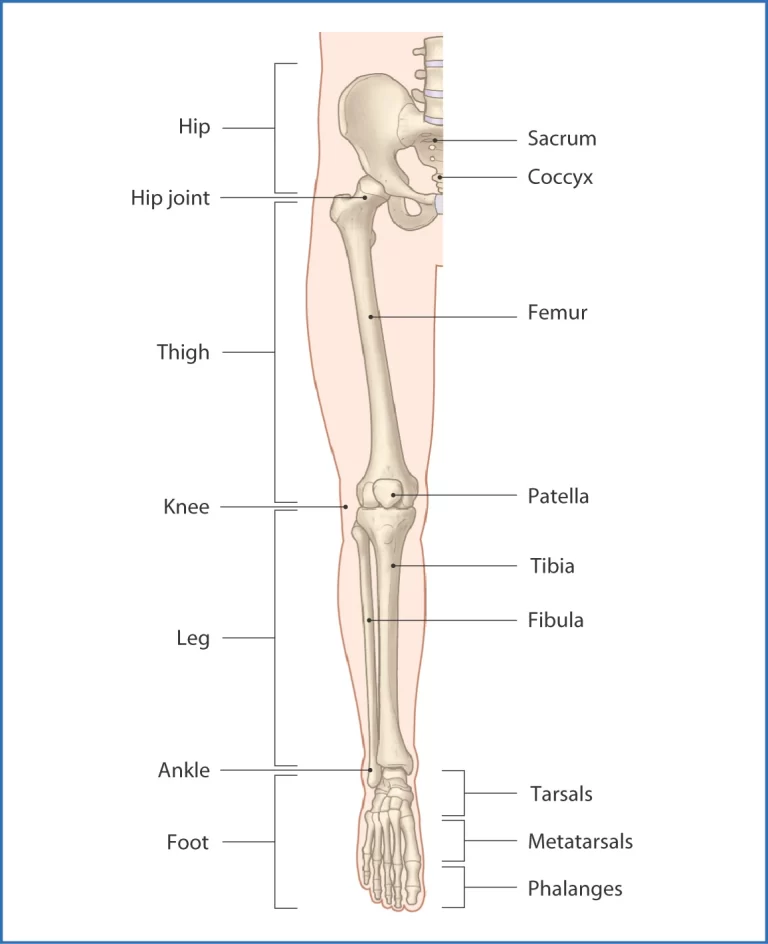

5 Comments